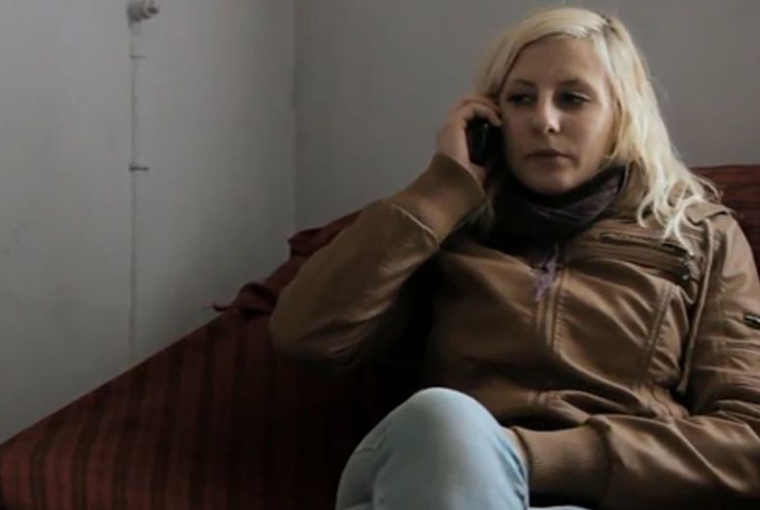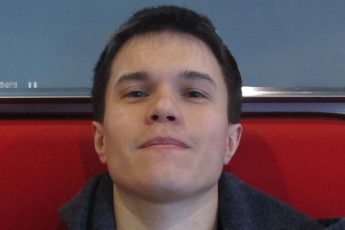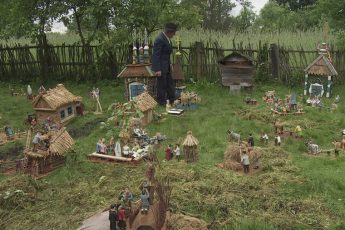A Film on the Young by the Young
Marta Prus’ Osiemnastka (2012)
Vol. 27 (March 2013) by Maxence Voiseux
Gosia, clad in a hip, brown leather jacket which contrasts with her sinister, derelict bedroom, talks to her mother on the phone.
– Mom, it’s Gosia. What time are you coming back tomorrow ?
– I’m leaving at nine tomorrow.
– But you have to be here early enough for us to go to the bank (…) God… I can’t take it anymore… I don’t care, you have to be here tomorrow in time for me to get the money…
When writing about a film, the critic cannot help but think of other films. In this case, it is La jeunesse a-t-elle une histoire? (“Does youth have a history?”) which opened the FIPA festival in January of 2013. Jacques Royer, the director claims it is a “film on youth”. Royer however, is past his prime and inevitably makes a theoretical treatise that classifies youngsters with tight-fit stereotypical labels. He claims to trace a history of youth, from the standpoint of someone who has lived through the May ’68 revolution and is now overwhelmed by the sight of such a new, dynamic and effervescent generation.
“They say we cease to understand youth once we realize that we have lost it,” regurgitates the author at the beginning of his film. When confronted with such cinematic awkwardness, this youth thinks that it would be ever more bold for youth to speak for itself. To speak of its own experience and of its place in society instead of trying to create an artificial “history” across different generations and epochs that have little to nothing in common.
Becoming an adult — the young Polish filmmaker Marta Prus explores this classic theme without making any philistine claims about youth.
Marta Prus presents us with Gosia, a brave but disconcerted protagonist. Gosia, released from a youth detention center, returns to a broken home. She will soon be 18 and she has promised herself that she will celebrate her birthday with her friends. Like young Westerners, she dreams of going out to nightclubs and taking her boyfriend with her.
While Rosetta (in the Belgian Dardenne brothers’ homonymous film) struggles to find work after being fired from the factory, Gosia knows little of the hardships of the real world. One thinks that she couldn’t care less. The only thought that preoccupies her mind is to spend the 1,500 zlotys that linger in her bank account. She just wants to have fun. However, it is her mother that controls and blocks the access to her account.
Gosia’s brother does not welcome his sister on her return from the youth detention center. Instead, he indulges in dangerous games that involve self-mutilation, such as setting his own hair on fire and putting it out before his scalp burns. These scenes are filmed plainly, without any flamboyance. Affection is rarely expressed in the film, even during the scenes between Gosia and her boyfriend, who only appears briefly.
When Gosia’s mother finally arrives, the apartment disintegrates into a profound indifference that is shared by everyone. The relationship between the characters is conveyed exclusively through images, which provide sufficient narrative substance to express the malaise which reigns over this family, long-abandoned by its father. Gosia’s hopes for a birthday party are confronted with the harsh financial reality of the family and a rough external world that she seems to have forgotten. The discord between Gosia and her mother reflects the image of a larger conflict between generations.
The director does not burden the film with any interviews, during which she would be forced to ask Gosia : “So, what do you want to do with your life?”
The young couple in Kiéslowski’s First Love regrets being forced into adulthood and not being able to follow their peers, carefree and unburdened by adult problems such as pregnancy. Gosia, on the other hand, does not seem to have any specific ambitions, but would rather imitate everyone else: to play, to hang out with her friends and let time fly by, without having to think about the future.
One cannot help but wonder how Gosia’s fate would have been different if she followed the great diaspora of Polish workers that fled their motherland, weary of having to wait for a brighter future.
Gosia dances inside a Warsaw nightclub, while rays of light fall on her glittery skirt. Marta Prus rightfully depicts Gosia as a symbol of a lost youth, fearful of an uncertain future, in a hyperactive era that’s ever-growing in speed. A film on the young, by the young. A handsome cinematic experiment that joins the vibrant Eastern Europe film community.
The French hip-hop band NTM sings:”Regarde ta jeunesse dans les yeux” (“Stare into the eyes of youth”). Marta Prus does so without indulgence.
Translation by Lucas Mikaberidze




Leave a Comment